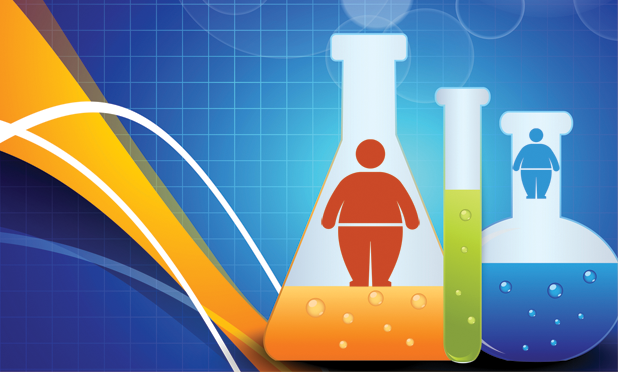At first, Ahmed El-Sohemy was puzzled by his data—they were the complete opposite of what they should have been. It was supposed to be a straightforward study of cholesterol metabolism in rats and merely replicate the protocol from another, previously published study. El-Sohemy initially assumed the discrepancy had something to do with the rat chow; but, no, he had fed the rats the very same high-cholesterol feed as in the previous study, and the blood levels of cholesterol reflected that. Had he skipped a step? Taken the wrong measurement? He leafed through his lab notes, but, again, no, he had followed the previous study precisely.
This was in the late 1990s, just before the turn of the millennium, and the human genome was a few short years away from being completely sequenced. El-Sohemy (Figure 1) was close to completing his Ph.D. degree in nutritional sciences at the University of Toronto, and, as he sat in his laboratory gazing at the rows of cages filled with frenetic rodents, he had a thought: “Maybe it’s the rats themselves.” Indeed, different types of rats are used for different types of research: the albino Wistar rat is spry and sometimes hypertensive, while Long–Evans rats, although physically identical to Wistars, are a bit more tame and lethargic—a great option for medical and nutritional research. In fact, the study El-Sohemy replicated had used a different strain of rat. Bingo!
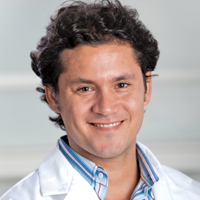
University of Toronto professor who
found a link between genetics and
metabolism.
He replicated the study using both strains of rats, and, sure enough, each strain responded to the same high-cholesterol feed in completely opposite ways. Might humans with different genetic profiles show a similar result? “As I delved deeper into the science,” El-Sohemy says, “it became clear that, yes, absolutely—[as] we’ve known for a long time—what’s good for one person is not necessarily good for another.”
Once the human genome was fully sequenced, El-Sohemy realized the impact this discovery might have. “This is definitely the future of nutrition,” he remembers thinking. His subsequent studies revealed dramatic differences in nutritional responses between patients with differing genetic profiles—an excess of four cups of coffee per day can either help or hurt you, depending on your genes. Other genes affect satiety, the feeling of being full, as well as energy metabolism and taste. If we could predict an individual’s response to particular activities and food choices, perhaps we could more efficiently tackle some of the most pressing health issues we face today, like obesity.
America, You’re Fat
Much of the world has a troubling weight problem that has grown to epidemic proportions. Last year, the Centers for Disease Control and Prevention (CDC) reported that nearly 40% of Americans are considered obese, the highest percentage to date. This rate is alarming from a public health standpoint because obesity is taxing to the whole body and often leads to serious health conditions like diabetes, heart disease, stroke, and some forms of cancer. Michelle Obama, out of concern about the dramatic rise in the childhood obesity rate, famously launched the “Let’s Move” initiative in 2010, declaring, “The physical and emotional health of an entire generation and the economic health and security of our nation are at stake.” Indeed, the rise in obesity-related diseases has placed what the CDC deems an inordinate financial burden on our public healthcare system, costing upwards of US$147 billion per year in the United States.
But obesity is very tricky to treat, largely because different bodies respond to diet and exercise in different ways. Yet current treatment models prescribe a one-size-fits-all approach—exercise and relatively uniform recommendations for diet modification. El-Sohemy claims this does not align with the most up-to-date research. “The current model is based on research that is what I call old science,” he explains, “science from ten to 15 years ago based on group averages. At the end of the day, people don’t really care what works for the population. They want to know what works for them.”
A Targeted Genetic Approach
El-Sohemy’s early work tapped into the budding field of nutrigenomics, the study of interactions between genes and nutrients, and he has since become a leader in the field. Now a professor of nutritional sciences at the University of Toronto, he sees the outliers in his data as the most interesting—it’s the best place to look for biological root causes of health problems, including obesity. An assortment of genes lay the foundations for obesity, and yet others make it difficult to treat individual patients. Some people have carb cravings, metabolizing carbohydrates less efficiently than fat. Some don’t respond to exercise or high-protein diets, while others do. “We’re identifying many genes that can help us predict whether or not a particular intervention is going to be effective in terms of weight loss,” says El-Sohemy. This, he claims, gives patients a leg up in treatment.
In 2011, he started Nutrigenomix, a company that provides individualized recommendations based on a patient’s genetic profile gathered from a saliva sample. After one week of processing and screening, a patient receives a comprehensive report based on the most current science, which is interpreted by a licensed dietitian or other healthcare provider. Currently, the company works with over 7,000 authorized providers in 35 countries and provides reports in seven different languages, according to its website.
Some researchers claim this treatment strategy isn’t quite ready for prime time. Cristiana Pavlidis, a dietitian at the University of Patras, Greece, and her colleagues write in a 2015 Applied & Translational Genomics paper, “Nutrigenomics: A Controversy,” that “research on nutrigenomics and, in particular, obesity is still ongoing.” It is their view that “there are steps that need to be considered in order for nutrigenomics to be applied: the genes, the gene/protein network, and the strategy toward the determination of the nutrients’ influence on gene/protein expression.” El-Sohemy agrees there is more to do on the research front, but, to him, “the future is here.” The controversy, he argues, is more an issue for companies like 23andMe, which predict a patient’s genetic risk for disease based on incomplete science. However, predicting nutritional outcomes is more straightforward, according to El-Sohemy. “There are hundreds of genetic markers that have been linked to obesity,” he says, “genes that affect satiety, genes that affect energy metabolism, genes that affect taste, all having these tiny, tiny individual effects.” If you’re trying to lose weight, he continues, Nutrigenomix will merely tell you how you’re most likely to succeed. And this is all communicated through a healthcare professional who helps relay and explain the results—something other companies don’t offer.
Other Ways to Fight Fat
Diet and exercise will never do the trick for some obese patients. That makes other strategies necessary. Most solutions that involve a procedure are not only invasive but often temporary—for example, gastric bypass surgery, which shrinks the stomach and reroutes the intestines to lessen a person’s appetite, or fat removal procedures like liposuction, CoolSculpting, and laser treatment.
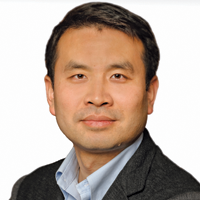
University discovered a substance
to convert white fat into the more
easily metabolized brown fat.
Li Qiang, an assistant professor of pathology and cell biology at Columbia University in New York, wanted to find a way to tackle problem areas, like love handles or double chins, locally (Figure 2). These areas are typically hard to treat because they contain white fat composed of large, harder-to-burn triglycerides. “It persists, no matter how hard you work,” explains Qiang. Brown fat, on the other hand, is composed of smaller triglycerides and also contains a larger number of mitochondria, organelles in cells responsible for energy production and thus fat burning. Qiang had already developed a drug to convert white fat into easier-to-burn brown fat (the fat breakdown process is called lipolysis), but he wanted to figure out a good, noninvasive way to deliver the drug locally to problem areas. He read about a scientist, Zhen Gu, an associate professor of biomedical engineering at the University of North Carolina at Chapel Hill, who had recently developed a patch for delivering insulin, a technology that might also work with his drug (Figure 3).
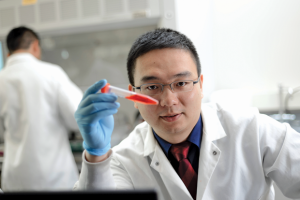
was developed by Zhen Gu, a faculty member with the
University of North Carolina at Chapel Hill.
Together, Qiang and Gu tested their obesity patch on mice, and it worked. “We also found it improved the metabolism of the mice,” says Gu. The mice lost 20% of their fat in just a month.
Qiang’s drug is already FDA-approved for use in humans, so the patch is currently on the fast track for approval. Qiang and Gu will soon begin testing the medicated patch, first working through some designs to increase safety using nanoparticles that better sequester the drug in the body’s problem areas. If all goes well, the two hope to eventually sell the patch at pharmacies to be applied by the patient at home. This is not, however, a treatment for overall obesity, Qiang clarifies. “Obesity is still obesity,” he says. “It’s mainly for cosmetic use for moderate to mildly obese people.”
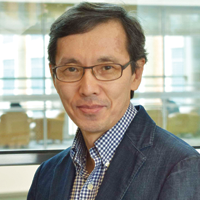
National Institutes of Health and has
developed a substance to suppress an
obesity-related enzyme.
Other new research shows promise as well, such as a potentially new class of drugs to help patients combat weight gain during middle age. Jay Chung, a senior investigator at the Laboratory of Obesity and Aging Research, part of the National Institutes of Health, was curious as to why middle-aged people seem to gain weight, even without changing diet and exercise habits (Figure 4). “Obesity is really age-related for most people. There are a lot of people that are as skinny as a chopstick in their twenties, but become quite heavy at their middle age,” he notes. In an effort to tease apart the reasons behind this, he observed an interesting phenomenon in rats: two different types of rats—those bred to be “high-capacity runners” and “low-capacity runners” (or, as Chung refers to them, “marathon runners versus couch potatoes”)—had different levels of an enzyme called DNA-PK. Couch potatoes, it turned out, had more of the enzyme than the marathon runners. DNA-PK suppresses another enzyme called ANPK, which is important for the production of mitochondria. More DNA-PK, therefore, means less fat burning. Chung observed the same phenomenon in mice and Rhesus monkeys.
He next developed a substance to inhibit the enzyme, which he put into high-fat chow that he fed to mice. Those that consumed the inhibitor showed a 40% decrease in weight gain. Similar studies in humans might eventually lead to a new class of drug that inhibits DNA-PK, but more research is needed to get a complete picture of the enzyme’s role in the body. So far, it has also been linked to other important functions, like insulin signaling regulation and DNA repair, an important task as the body ages and DNA quality degrades. “One concern may be that these drugs may decrease DNA repair,” Chung continues. “We have not seen that with the dosage that we’ve used in mice, but that’s something one would be concerned about.”
Beyond Obesity
Understanding what makes a person obese is important for reasons beyond vanity or even obesity-related health issues. Understanding the mechanisms that lead to obesity is providing a better sense of the human body in general and how it processes energy. And this only highlights the need to understand our differences. El-Sohemy envisions a world where everyone has a basic understanding of the interaction between his or her genes and the food he or she eats. He has already begun working with food companies and grocery stores to create labels for foods that will help people eat according to their genes. He’s also communicated with supplement companies about creating customized supplements based on one’s genetics.
In terms of the science, the future is bright. “We’re going to be learning more and more how these different kinds of genetic markers affect our requirements for different nutrients and how that ultimately impacts a variety of different health conditions,” says El-Sohemy. “Some people have a fatalistic view of their genetics—’it’s in my genes, there’s nothing I can do about it’— but that’s not the case. We’re looking at how to work with your genes.” There are, after all, many ways to achieve a desired outcome.



